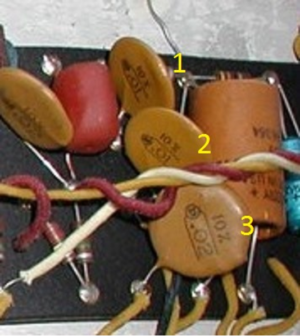The blackface Princeton Reverb Tremolo employs the standard oscillation circuit of three Hi-Pass RC filters in series that act in 60˚ increments to shift the phase of the inverted plate signal 180˚, thus reinforcing the oscillation.
In the AA1164 Fender circuit schematic, the three capacitors of the tremolo circuit are .01 µF, .02 µF, and .02 µF. This is different from other Fender tremolo circuits which use .01, .01, and .02. This is true of the higher-power amps like the Twin Reverb, which use the opto-isolator tremolo, as well as the lower-power amps like the Deluxe Reverb and Vibrolux, which use the direct bias tremolo, like the Princeton Reverb.
The interesting thing is that in every Princeton Reverb I have seen, the capacitors in the tremolo are .01, .01, and .02; not .01, .02, .02 as shown in the AA1164 schematic.

And here is the “standard” Fender tremolo circuit, also with capacitors numbered:

Finally, this is a typical Princeton Reverb tremolo section on the eyelet board, with the caps numbered. Note that you can read the values, and they are .01, .01, .02. They don’t agree with the schematic:

What does this mean in terms of the operation of the tremolo?
The change of the cap value from .01 to .02µF would not affect the phase shift of the section – it’s still 60˚. However, the change to a higher cap value here will change the speed of the tremolo effect. This will lower the speed of the tremolo. With a .01, .01, .02 cap series, the lowest speed will be about 5 Hz. With the .01, .02, .02 cap series, the lowest speed will be significantly lower than 5 Hz.

